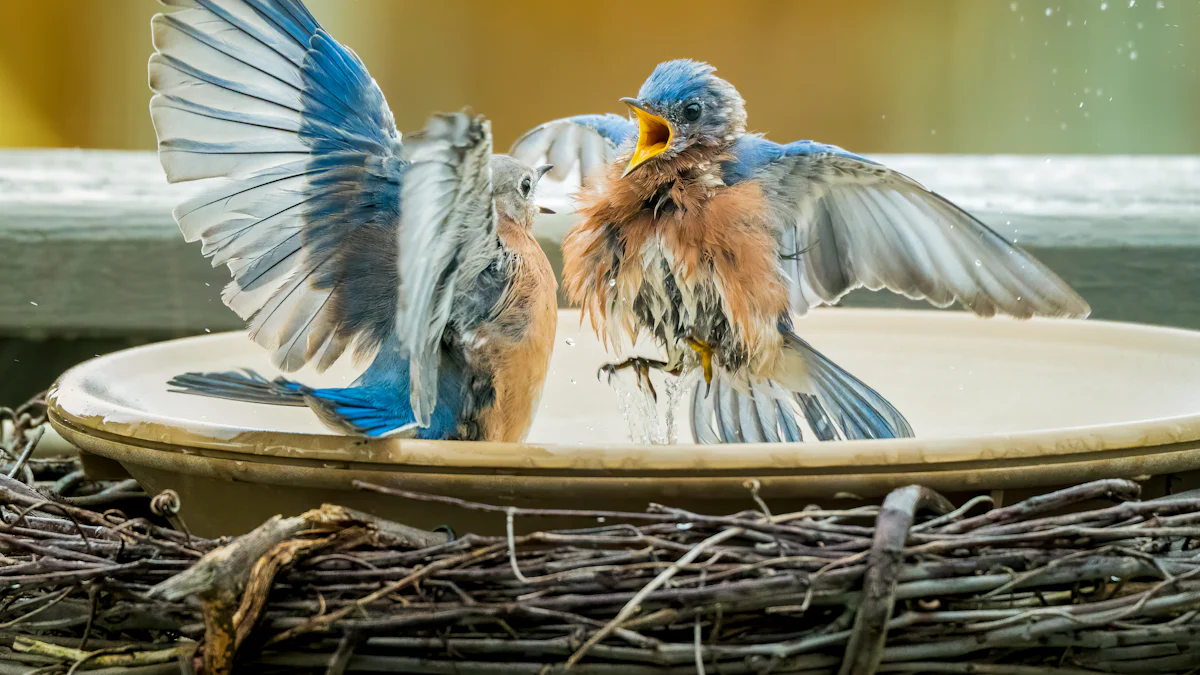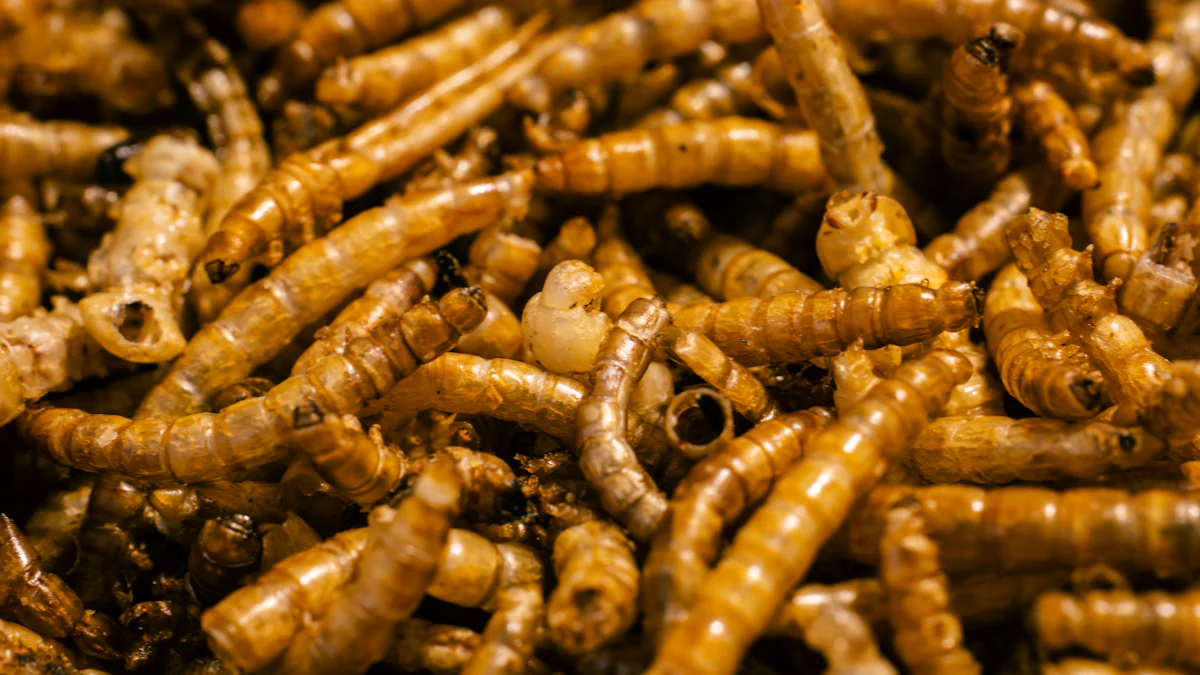
Are live mealworms for birds better than dried ones? It depends on your goals. Live mealworms for birds are easier for young birds to digest and mimic natural foraging. Dried mealworms, on the other hand, are packed with protein, fats, and fiber, making them a great year-round food source. Both options benefit birds during breeding and migration.
Key Takeaways
- Moving live mealworms draw more birds, like bluebirds, to eat.
- Dried mealworms are simple to store and healthy all year.
- Soaking dried mealworms softens them and gives birds water.
Dried vs. Live Mealworms: What’s the Difference?
Processing and Storage Methods
When it comes to storage, live and dried mealworms couldn’t be more different. Live mealworms need a cool, dark place with good ventilation. You’ll also have to feed them to keep them alive. If you care for them properly, they can last for months. However, if they start to smell bad or look strange, it’s time to toss them.
Dried mealworms are much easier to store. Keep them in a cool, dry spot, and they’ll stay good for a year or more. But watch out for moisture! If they get wet, they can grow mold or develop a musty smell.
Nutritional Differences
Live and dried mealworms both pack a punch when it comes to nutrition, but they’re not identical. Live mealworms contain about 20% protein and 13% fat, along with a high moisture content of 62%. Dried mealworms, on the other hand, are more concentrated. They offer 53% protein and 28% fat, with only 6% moisture.
Here’s a quick comparison:
| Type | Protein Content | Fat Content | Moisture Content |
|---|---|---|---|
| Live Mealworms | 20% | 13% | 62% |
| Dried Mealworms | 53% | 28% | 6% |
Dried mealworms are also packed with fiber, making them a great year-round food source for wild birds. If you soak them in water first, they can even help birds stay hydrated during hot summer days.
Bird Preferences and Behavior
Birds love live mealworms because they move! That wriggling motion triggers their natural hunting instincts. You’ll notice birds flocking to your feeder when you offer live mealworms for birds.
Dried mealworms are still a solid choice, especially if you’re looking for convenience. Birds will eat them, particularly when live options aren’t available. However, live mealworms tend to attract more attention, even though they require more effort and cost to maintain.
Both types of mealworms provide excellent nutrition, so it really depends on what works best for you and your feathered visitors.
Nutritional Benefits of Mealworms for Birds

Protein and its Importance for Bird Health
Protein is one of the most critical nutrients for birds. It helps them grow, stay strong, and maintain their energy levels. Mealworms, whether live or dried, are an excellent source of protein. They’re especially beneficial for young birds, as protein supports healthy growth and development. During breeding seasons, birds need extra protein to lay eggs and care for their chicks.
Here’s a quick look at how protein in mealworms benefits birds:
| Benefit | Description |
|---|---|
| Promotes Healthy Growth and Development | Mealworms provide essential protein for young birds’ growth and development. |
| Supports Reproduction and Egg-Laying | The nutrients in mealworms are crucial during breeding and egg-laying periods. |
| Boosts Energy Levels | Mealworms offer energy that helps birds remain strong, especially during migration or cold weather. |
Other Essential Nutrients in Mealworms
Mealworms are packed with more than just protein. They’re loaded with essential fats, B vitamins, and minerals like iron and zinc. These nutrients keep birds healthy and active. Fats provide energy, especially during migration or colder months. B vitamins support metabolism, while minerals strengthen bones and boost immunity.
Here’s a breakdown of the key nutrients in mealworms:
| Nutrient | Benefit |
|---|---|
| Protein | Supports feather production and overall vitality |
| B vitamins | Supports metabolism |
| Minerals | Essential for bird health |
| Amino acids | Important for growth and repair |
Mealworms also contain fibers that aid digestion and help birds stay healthy year-round.
Benefits During Breeding and Molting Seasons
Mealworms are a powerhouse of nutrition during breeding and molting seasons. Birds need extra energy and nutrients to lay eggs, raise chicks, and grow new feathers. The high protein and fat content in mealworms make them perfect for these demanding times. Live mealworms for birds are especially helpful because they’re easier to digest, particularly for young or molting birds.
Dried mealworms are also a great option. Soaking them in water before feeding provides hydration, which is crucial during hot summer months. Whether you choose live or dried mealworms, you’ll be giving your feathered friends the fuel they need to thrive.
Practical Considerations for Bird Feeders
Storage and Shelf Life Comparison
When it comes to storage, live and dried mealworms have very different needs. Live mealworms need a cool, dark space with good ventilation. You’ll also have to feed them and keep them hydrated. If you refrigerate them at 45-50°F, they can last 6-10 weeks. Without refrigeration, they’ll only stay usable for about three weeks. Proper care can extend their lifespan to several months, but it takes effort.
Dried mealworms are much easier to manage. Store them in a cool, dry place, like a cupboard, and they’ll last up to six months. For even longer shelf life, you can freeze them, which keeps them fresh for up to a year. Since they’re dried, they don’t spoil as quickly as live mealworms. This makes them a more convenient option if you don’t want to deal with the hassle of live insects.
Cost-Effectiveness of Dried vs. Live Mealworms
Live mealworms for birds are more expensive than dried ones. However, their movement makes them irresistible to birds, which can justify the higher cost. If you’re looking to attract more birds to your feeder, live mealworms might be worth the investment. On the other hand, dried mealworms are more budget-friendly and easier to handle. They still provide excellent nutrition, even if they don’t draw as much attention as live ones.
Convenience and Ease of Feeding
Feeding live mealworms comes with a few challenges. Birds love them, but you’ll need to keep them alive and hydrated. They also require regular care, like feeding and cleaning their container. Some birds might not recognize dried mealworms as food right away, but soaking them in water can help. This makes them softer and more appealing, especially during hot summer months when hydration is crucial.
Dried mealworms are the clear winner when it comes to convenience. You can store them for months without worrying about feeding or maintaining them. Just scoop some out and add them to your feeder. They’re perfect for busy bird enthusiasts who want to provide a nutritious treat without the extra work.
Tips for Feeding Mealworms to Birds
Introducing Mealworms to Backyard Birds
Getting birds to notice mealworms in your yard is easier than you think. Start by using a platform or tray feeder with sides at least 1 inch tall. This keeps live mealworms from escaping. Place the feeder in a visible spot, preferably near shrubs or trees, so birds feel safe while feeding. Protect the mealworms from rain by using a feeder with a roof or drainage holes.
Offer mealworms year-round, especially during winter and nesting seasons when birds need extra energy. If you’re using live mealworms, store them in a shallow plastic container with a perforated lid. Add apples for moisture and bran or oatmeal for nutrition. Refrigerate them to slow their growth and keep them fresh for weeks.
Feeding Live Mealworms Effectively
Live mealworms for birds are a surefire way to attract attention. Their movement triggers birds’ natural hunting instincts. Offer them briefly at first to help birds recognize them as food. Once the birds get used to the routine, you can switch to dried mealworms for convenience.
To keep live mealworms healthy, store them in a ventilated container with a screen lid. Feed them bran or oatmeal and add apple slices for hydration. Refrigerating them slows their growth, ensuring they stay in their larval form longer.
Rehydrating Dried Mealworms for Better Results
Dried mealworms are packed with protein, fats, and fiber, making them a fantastic year-round food source for wild birds. Soaking them in lukewarm water before serving makes them softer and more appealing. This also provides birds with much-needed hydration, especially during hot summer months.
For an extra boost, mix rehydrated mealworms with other bird food. Pairing them with water nearby helps digestion and keeps birds coming back for more. Once one bird discovers the mealworms, others will quickly follow.
Choosing between live and dried mealworms depends on your goals and the birds you want to attract. Live mealworms for birds are irresistible due to their movement, making them ideal for picky eaters like bluebirds. Dried mealworms, packed with protein, fats, and fiber, are a convenient year-round option.
To start, offer live mealworms in small amounts to draw birds in. Once they’re familiar, switch to dried mealworms for ease. Soaking dried mealworms in water boosts their appeal and provides hydration, especially in summer. Experiment with both to see what works best for your feathered visitors.
FAQ
How many mealworms should you feed birds daily?
You can start with 10-15 mealworms per bird daily. Adjust based on how many birds visit your feeder and how quickly they eat them.
Can you mix mealworms with other bird food?
Absolutely! Mix mealworms with seeds, suet, or fruits. This creates a balanced diet and attracts a wider variety of birds to your yard.
Tip: Soak dried mealworms in water first. This softens them and provides hydration, especially during summer months. Birds will love the extra moisture!
Are dried mealworms as good as live ones?
Yes! Dried mealworms are packed with protein, fats, and fiber. Soaking them in water boosts hydration, making them a fantastic year-round food source for wild birds.


